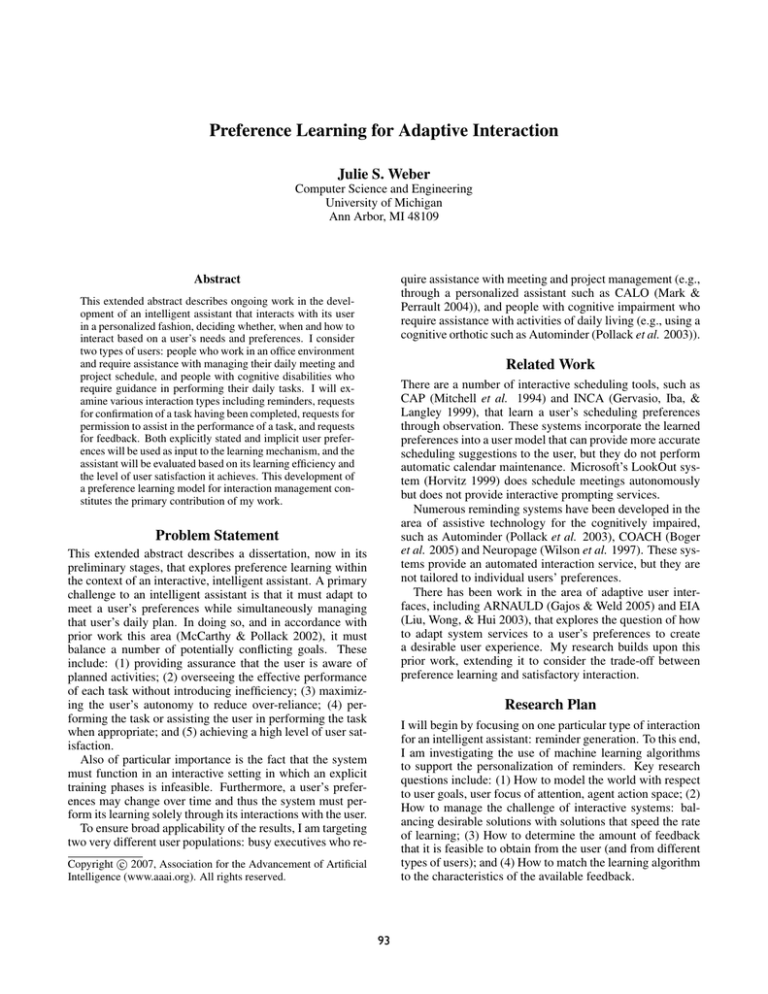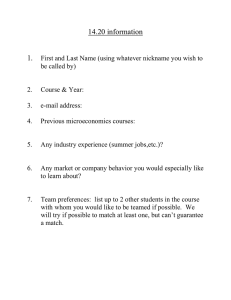
Preference Learning for Adaptive Interaction
Julie S. Weber
Computer Science and Engineering
University of Michigan
Ann Arbor, MI 48109
Abstract
quire assistance with meeting and project management (e.g.,
through a personalized assistant such as CALO (Mark &
Perrault 2004)), and people with cognitive impairment who
require assistance with activities of daily living (e.g., using a
cognitive orthotic such as Autominder (Pollack et al. 2003)).
This extended abstract describes ongoing work in the development of an intelligent assistant that interacts with its user
in a personalized fashion, deciding whether, when and how to
interact based on a user’s needs and preferences. I consider
two types of users: people who work in an office environment
and require assistance with managing their daily meeting and
project schedule, and people with cognitive disabilities who
require guidance in performing their daily tasks. I will examine various interaction types including reminders, requests
for confirmation of a task having been completed, requests for
permission to assist in the performance of a task, and requests
for feedback. Both explicitly stated and implicit user preferences will be used as input to the learning mechanism, and the
assistant will be evaluated based on its learning efficiency and
the level of user satisfaction it achieves. This development of
a preference learning model for interaction management constitutes the primary contribution of my work.
Related Work
There are a number of interactive scheduling tools, such as
CAP (Mitchell et al. 1994) and INCA (Gervasio, Iba, &
Langley 1999), that learn a user’s scheduling preferences
through observation. These systems incorporate the learned
preferences into a user model that can provide more accurate
scheduling suggestions to the user, but they do not perform
automatic calendar maintenance. Microsoft’s LookOut system (Horvitz 1999) does schedule meetings autonomously
but does not provide interactive prompting services.
Numerous reminding systems have been developed in the
area of assistive technology for the cognitively impaired,
such as Autominder (Pollack et al. 2003), COACH (Boger
et al. 2005) and Neuropage (Wilson et al. 1997). These systems provide an automated interaction service, but they are
not tailored to individual users’ preferences.
There has been work in the area of adaptive user interfaces, including ARNAULD (Gajos & Weld 2005) and EIA
(Liu, Wong, & Hui 2003), that explores the question of how
to adapt system services to a user’s preferences to create
a desirable user experience. My research builds upon this
prior work, extending it to consider the trade-off between
preference learning and satisfactory interaction.
Problem Statement
This extended abstract describes a dissertation, now in its
preliminary stages, that explores preference learning within
the context of an interactive, intelligent assistant. A primary
challenge to an intelligent assistant is that it must adapt to
meet a user’s preferences while simultaneously managing
that user’s daily plan. In doing so, and in accordance with
prior work this area (McCarthy & Pollack 2002), it must
balance a number of potentially conflicting goals. These
include: (1) providing assurance that the user is aware of
planned activities; (2) overseeing the effective performance
of each task without introducing inefficiency; (3) maximizing the user’s autonomy to reduce over-reliance; (4) performing the task or assisting the user in performing the task
when appropriate; and (5) achieving a high level of user satisfaction.
Also of particular importance is the fact that the system
must function in an interactive setting in which an explicit
training phases is infeasible. Furthermore, a user’s preferences may change over time and thus the system must perform its learning solely through its interactions with the user.
To ensure broad applicability of the results, I am targeting
two very different user populations: busy executives who re-
Research Plan
I will begin by focusing on one particular type of interaction
for an intelligent assistant: reminder generation. To this end,
I am investigating the use of machine learning algorithms
to support the personalization of reminders. Key research
questions include: (1) How to model the world with respect
to user goals, user focus of attention, agent action space; (2)
How to manage the challenge of interactive systems: balancing desirable solutions with solutions that speed the rate
of learning; (3) How to determine the amount of feedback
that it is feasible to obtain from the user (and from different
types of users); and (4) How to match the learning algorithm
to the characteristics of the available feedback.
c 2007, Association for the Advancement of Artificial
Copyright Intelligence (www.aaai.org). All rights reserved.
93
lier reminder for lunch than for his afternoon engagements?
And if so, how will the system model exceptions to these
preferences? Finally, it is critical to consider the situation in
which a user’s preferences evolve over time, and in particular how our system will account for such circumstances.
A person’s preferences may be expressed explicitly or implicitly. If the system provides its user with choices, or allows for feedback or for the user to initialize the system’s
user model with certain preferences or goals, then that system has access to explicitly stated preferences (such as: I
prefer a voice prompt to a beeping noise). In contrast, the
system can recognize implicit user preferences by monitoring the amount of user success with respect to the interactions that the system offers its user (e.g., recognizing that the
user performs a task immediately upon receiving a prompt
for that task generally indicates a successful prompt).
I plan to study the manner in which a system can learn
a user’s explicit preferences over the type of assistance the
user receives. This includes (1) allowing the user to input
preferences at the onset of communication with the assistant,
(2) providing the user with choices from which the user can
choose the most favorable option, and (3) requesting user
feedback to be incorporated into future decision making.
I have completed work in the area of active learning of
scheduling preferences (Weber & Pollack 2007), in which
the user of an interactive calendar program is presented with
a series of scheduling options, and the user’s choice of the
most desirable option is used to adjust the system’s user
model. Similarly, in the domain of adaptive reminding, a
user can be prompted in various ways for a particular task.
I have also developed a simulator for testing the results of
using various interaction mechanisms for learning explicit
and implicit user preferences. A preliminary version of this
simulation system is described in (Weber & Pollack 2005).
To test a system’s learning of implicit user preferences, I
will incorporate activity recognition into the learning framework and compare against a baseline interaction strategy in
which reminding features (such as timing and signal type)
are chosen randomly. The resulting framework will be
paired with the explicit preference learning engine to create a full reminding system. Then, once I have achieved
success in the reminding domain I will extend the system
to handle other forms of interactions and address the issue
of agent-driven adjustable autonomy: allowing the system
to decide which scenarios may warrant which forms of assistance in addition to, or in lieu of, some form of passive interaction. This requires developing a model of adjustable autonomy (Bradshaw et al. 2004), and formalizing the problem of computing the expected risk and benefit
of performing actions on behalf of the user (Berger 1985;
Horvitz, Breese, & Henrion 1988).
References
Berger, J. O. 1985. Statistical Decision Theory and
Bayesian Analysis. New York: Springer.
Boger, J.; Poupart, P.; Hoey, J.; Boutilier, C.; Fernie, G.;
and Mihailidis, A. 2005. A decision-theoretic approach to
task assistance for persons with dementia. In Proceedings
of the Int’l Joint Conference on Artificial Intelligence.
Bradshaw, J. M.; Feltovich, P.; Jung, H.; Kulkarni, S.;
Taysom, W.; and Uszok, A. 2004. Dimensions of adjustable autonomy and mixed-initiative interaction. Lecture
Notes in Computer Science 2969:17–39.
Gajos, K. Z., and Weld, D. S. 2005. Preference elicitation
for interface optimization. In Proceedings of User Interface Software and Technology.
Gervasio, M.; Iba, W.; and Langley, P. 1999. Learning user
evaluation functions for adaptive scheduling assistance. In
Proceedings of the Int’l Conference on Machine Learning.
Horvitz, E. J.; Breese, J. S.; and Henrion, M. 1988. Decision theory in expert systems and artificial intelligence.
Journal of Approximate Reasoning, Special Issue on Uncertainty in Artificial Intelligence 2:247–302.
Horvitz, E. 1999. Principles of mixed-initiative user interfaces. In Proceedings of Computer Human Interaction
1999. ACM Press.
Liu, J.; Wong, C. K.; and Hui, K. K. 2003. An adaptive
user interface based on personalized learning. Intelligent
Systems 18:52–57.
Mark, B., and Perrault, R. C. 2004. Calo: Cognitive assistant that learns and organizes.
McCarthy, C. E., and Pollack, M. E. 2002. A plan-based
personalized cognitive orthotic. In Sixth International Conference on AI Planning and Scheduling.
Mitchell, T. M.; Caruana, R.; Freitag, D.; McDermott, J.;
and Zabowski, D. 1994. Experience with a learning personal assistant. Communications of the ACM 37:80–91.
Pollack, M. E.; Brown, L.; Colbry, D.; McCarthy, C. E.;
Orosz, C.; Peintner, B.; Ramakrishnan, S.; and Tsamardinos, I. 2003. Autominder: An intelligent cognitive orthotic
system for people with memory impairment. Robotics and
Autonomous Systems 44:273–282.
Weber, J. S., and Pollack, M. E. 2005. Simulating users
to support the design of activity management systems. In
Winter Simulation Conference.
Weber, J. S., and Pollack, M. E. 2007. Entropy-driven online active learning for interactive calendar management. In
Proceedings of the International Conference on Intelligent
User Interfaces.
Wilson, B.; Evans, J.; Emslie, H.; and Malinek, V. 1997.
Evaluation of neuropage: A new memory aid. Journal of
Neurology, Neurosurgery and Psychiatry 63:113–115.
Research Questions
There are a number of issues that must be addressed as this
research progresses. The first is the question of how to devise the proper evaluation metrics for the adaptive system,
i.e., how to concretely define “success” of an activity or task
such that it directly relates to the performance of the associated reminder. Will different levels of success or partial
completion of a task be detectable by an activity recognition
system? As listed above, it is also important to question the
amount of information that we can assume can be provided
by a user, as a seeding mechanism to the learning component. In other words, will a user know that he prefers an ear-
94




